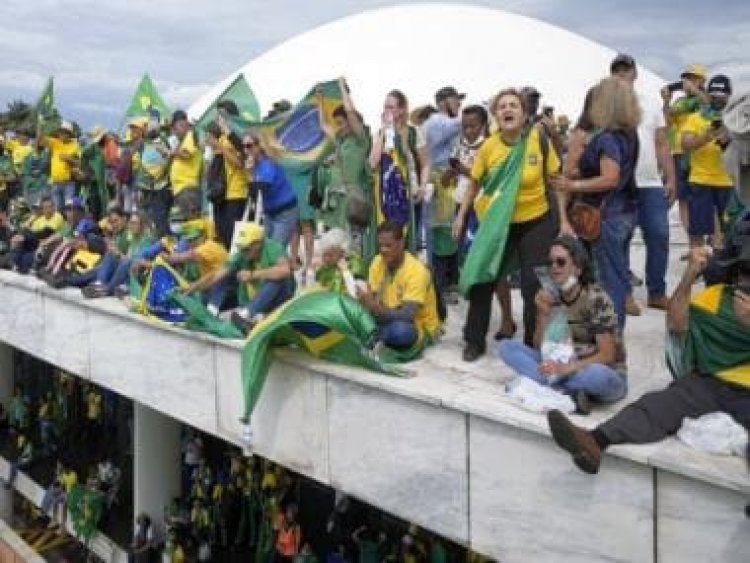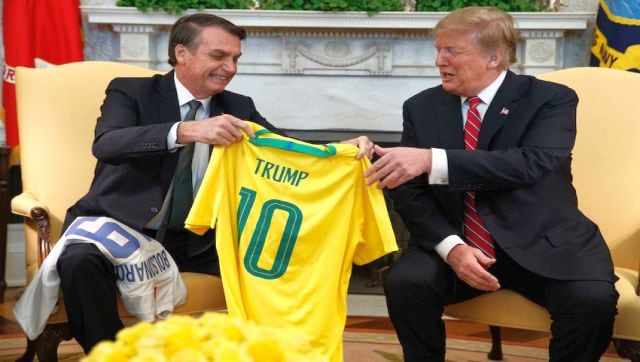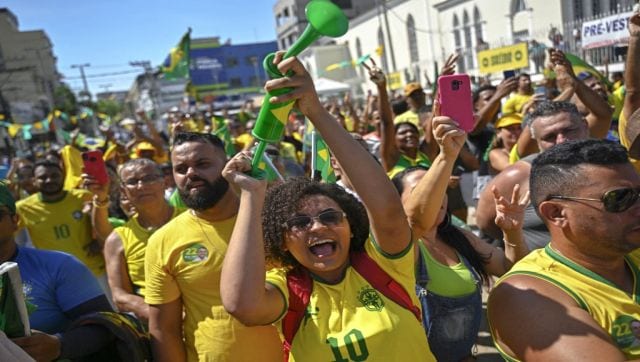Explained: Brazil’s iconic football jersey, its link to far-right Jair Bolsonaro and the 8 January riots
Explained: Brazil’s iconic football jersey, its link to far-right Jair Bolsonaro and the 8 January riots

On 8 January (Sunday), the Brazil Congress, the presidential palace (Palácio do Planalto) and the Supreme Court were overrun with the colours of yellow and green as thousands of supporters of far-right Jair Bolsonaro stormed the power centres of the nation.
Images of the storming were reminiscent of the US 6 January riots of 2021, when thousands of Donald Trump supporters attacked the Capitol building. But rather than seeing insurrection symbols, all one could see in Brasilia were protesters in the national football team’s iconic canary-coloured jersey — the canarinho.
After the protesters, who had damaged various artworks inside the buildings, were removed from the premises, the Brazilian Football Confederation (CBF), the country’s governing body of professional football, publicly condemned the far-right rioters and their use of the canarinho.
Also read: A Capitol Hill-Like Riot in Brazil: Why Bolsonaro’s supporters raided Congress, top court
“The Brazilian national team shirt is a symbol of the joy of our people,” the CBF said. “It’s to cheer, energise and love the country.”
The association also said that its national team jerseys, worn by Brazilian soccer legends such as Pelé, Rivaldo, Romário, Ronaldo, Ronaldinho, Kaka and Neymar Jr, should be used to unite the country instead of separating it. “The CBF is a non-partisan and democratic entity,” the CBF added. “We encourage that the shirt be used to unite and not divide Brazilians.”
But how did the iconic jersey get co-opted by the far-right?
Bolsonaro and the yellow jersey
Brazil’s bright yellow jersey — which is burnt into the imagination of a global audience — in recent times has become synonymous with Jair Bolsonaro, also known as the ‘Trump of the Tropics.
The yellow jersey became the talisman for the far-right in 2016 after the impeachment of Dilma Rousseff. According to Jorge Chaloub, a political sciences professor at Rio de Janeiro State University told The Athletic, “Before then, it was used by the left and right. But in 2016, the Brazil shirt became a symbol of the right.”
When Bolsonaro began campaigning to become president of Brazil in 2018, he used the colours — and the shirt — as a political symbol against Brazil’s left-wing parties. Once elected, he continued using the canarinho to build a connect with football and his brand of politics. When he visited then US president Donald Trump in 2019, Bolsonaro handed him a Brazilian jersey.

With Bolsonaro at the helm of affairs, his supporters took to embracing the canarinho — with them always wearing it and waving it from their balconies. They argued that they were “taking the country back” and that the Brazilian flag “would never be red” – in reference to an imagined communist threat.
And this became even more glaring during the 2022 Brazilian presidential elections. In October 2022, Bolsonaro told people to “wear yellow” ahead of the first round of polls. He had urged his voters by saying, “Vote this Sunday wearing the yellow shirt.”
After his appeal, many of Bolsonaro’s supporters cast their ballot wearing the iconic canary yellow football jersey.

Brazil’s most famous current player, Neymar, has shown up as one of Bolsonaro’s biggest supporters, endorsing him multiple times and elevating the link between the jersey and Bolsonaro.
The former president has used the canarinho as such an effective political weapon that today, the leftwing and his opponents are trying their hardest to reclaim the jersey.
Also read: Why Brazilians are giving up on their famous yellow football jerseys
President Luiz Inácio Lula da Silva in his attempt to reclaim the bright yellow had said that he would watch the Brazil-Serbia match during the FIFA World Cup 2022, wearing a canarinho with the number 13 – which represents his Workers’ party (PT) – emblazoned on the back. “We can’t be ashamed of wearing our green and yellow shirt,” Lula had told reporters. “(It) doesn’t belong to one particular candidate. It doesn’t belong to one particular party. Green and yellow are the colours of 213 million citizens who love this country.”
Several of Lula’s supporters, such as singer Ludmilla, international star Anitta, and rapper Djonga, have also made it a point of wearing the shirt during their performances. Djonga told a crowd at one concert that wearing the shirt in public was an act of protest.
“They (Bolsonaro supporters) think everything is theirs, they appropriate the meaning of family, they appropriate our national anthem, they appropriate everything,” he said. “But here’s the truth: everything is ours, nothing is theirs.”
Former footballer for the Brazilian national team, Walter Casagrande, also believes that an item he cherishes is being misrepresented. He was quoted as telling CNN, “Now I consider the Brazilian yellow jersey to have been kidnapped and appropriated by the right wing, so we cannot use it.”
Casagrande said that for him the power of the yellow shirt used to be that it represented democracy and freedom. “Brazil is appearing horribly to the world right now,” he said. “It’s the first time in my life I’m seeing the yellow jersey being used against democracy and freedom.”

History of the jersey
Incidentally, the Brazilian jersey, known the world around, wasn’t always green and yellow. Until the 1950 World Cup, Brazil’s football uniform was white and blue.
In 1950 when Brazil hosted the World Cup, it was the team to beat and it had reached the finals. However, the 1-2 loss to Uruguay at the Maracana stadium resulted in national mourning and a call to change the colours, because it was believed white and blue brought back luck.
Three years later, the newspaper Correio da Manha launched a competition for the design of the new team kit. The only rule the contest had was that the jersey had to use the colours of the Brazilian flag — yellow, blue, green and white.
After over 400 entries, the contest organisers chose 18-year-old Aldyr Garcia Schlee’s design as the winner. Schlee, who worked as an illustrator for a provincial newspaper in the southern state of Rio Grande do Sul, had submitted a sketch of a yellow jersey with a green collar and white socks.
The new kit was used for the first time in a friendly in 1954 and later that year in the World Cup in Switzerland. Even though they were knocked out from the World Cup in the quarterfinals, they chose to remain with the yellow jersey.
But, Brazil made history four years later when it won its first World Cup in Sweden, with Pelé and Garrincha, and immortalising the jersey designed by Schlee.
With inputs from agencies
Read all the Latest News, Trending News, Cricket News, Bollywood News,
India News and Entertainment News here. Follow us on Facebook, Twitter and Instagram.
What's Your Reaction?



























































